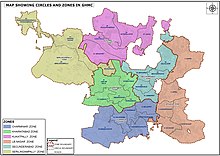Greater Hyderabad Municipal Corporation
[7] In the same year, Sir Salar Jung I, the then Prime Minister of Hyderabad State under the Nizam, constituted the Department of Municipal and Road Maintenance.During the following year (1934), the first elections were held for Municipal Corporation and a Standing Committee was appointed at that time.Again in 1950, Hyderabad regained its lost Corporation status along with the amalgamation of Jubilee Hills Municipality.The municipalities are L. B. Nagar, Gaddi Annaram, Uppal Kalan, Malkajgiri, Kapra, Alwal, Quthbullapur, Kukatpally, Serilingampally, Rajendranagar, Ramachandrapuram, and Patancheru.The panchayats are Shamshabad, Satamarai, Jallapalli, Mamdipalli, Mankhal, Almasguda, Sardanagar and Ravirala.Now, the Supreme Court has rejected the plea to interfere into the matter, the Andhra Pradesh government has passed the GO 261 that is related to the creation of Greater Hyderabad on 16 April 2007.Earlier, the twin cities of Hyderabad and Secunderabad had a population of 45 lakhs living in an area of 172 km2.The new urban agglomeration sprawls across 625 square kilometres (241 sq mi) with a population of 67 lakhs.The corporators are responsible for overseeing that their constituencies have the basic civic infrastructure in place, and that there is no lacuna on the part of the authorities.[21][17][18] The body is responsible for administering and providing basic infrastructure to the city: GHMC co-ordinates with various other government organizations like: etc.


Emblem of the Greater Hyderabad Municipal CorporationMunicipal corporationGadwal Vijayalakshmi11 February 2021Deputy MayorMunicipal commissionerOfficial oppositionOther opposition1 December 2020HyderabadTelanganalargest municipal corporations in IndiaSir Salar Jung IHyderabad StateChaderghatmunicipal corporationsMunicipal Corporation of HyderabadL. B. NagarGaddi AnnaramUppal KalanMalkajgiriQuthbullapurKukatpallySerilingampallyRajendranagarRamachandrapuramPatancheruRangareddy districtMedak districtShamshabad30 circles and 150 wardsOld CityBombay Stock ExchangeRanga Reddy districtMankhalAlmasgudaHyderabad districtMedchal districtSangareddy districtList of mayors of HyderabadAdministrative divisions of HyderabadSecunderabadHyderabad Metropolitan Development AuthorityHMWS&SBHyderabad Traffic PoliceTSSPDCLIrrigation2020 Greater Hyderabad Municipal Corporation electionTelangana Rashtra SamithiBharatiya Janata PartyAll India Majlis-e-Ittehadul MuslimeenIndian National CongressTelugu Desam Party2016 Greater Hyderabad Municipal Corporation election2009 Greater Hyderabad Municipal Corporation electionIndependents2002 Hyderabad Municipal Corporation electionTelangana Sadhana SamithiThe Times of IndiaKarimnagarKarimnagar Municipal CorporationKhammamKhammam Municipal CorporationNizamabadNizamabad Municipal CorporationPeddapalliRamagundam Municipal CorporationWarangalGreater Warangal Municipal CorporationHistoryHasmathpet cairnsQutb Shahi DynastySiege of GolcondaNizams of HyderabadAsaf Jahi dynastyGreat Musi Flood of 1908Telangana RebellionAnnexation of HyderabadHyderabad District CollectorateQuli Qutb Shah Urban Development AuthorityTelangana SecretariatRashtrapati NilayamHigh CourtTelangana LegislatureTourist attractionsCharminarMecca MasjidFalaknuma PalaceGolcondaChowmahalla PalaceQutb Shahi tombsTaramati BaradariKing Kothi PalacePaigah TombsCity WallBritish ResidencyMoazzam Jahi MarketHeritage structuresSultan Nagar FortNehru Zoological ParkPublic GardensNTR GardensLumbini ParkRamoji Film CityIndira ParkSanjeevaiah ParkSnow WorldJalaviharJalagam Vengal Rao ParkTemplesBirla MandirKarmanghat Hanuman TemplePedamma TempleChilkoor Balaji TempleJagannath TempleMosquesMakkah MasjidKhairtabad MosqueKulsum Begum MasjidToli MasjidMusheerabad MasjidChurchesSt. John'sSt. Joseph'sSt. George'sParsi Fire Temple